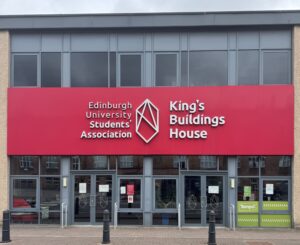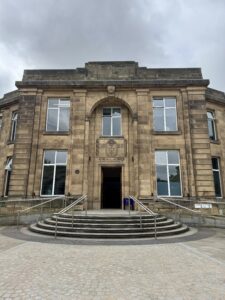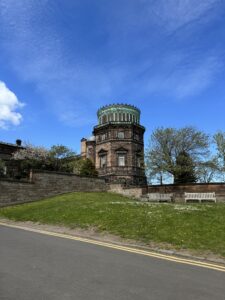Kings Buildings House
KB House is the student union at the University’s King’s Buildings campus, currently run by the Edinburgh University Student Association (EUSA). EUSA was founded in 1973 as a merger of various unions, and the King’s Buildings House union was not added until 1989.
EUSA’s activities are very broad, ranging from organising events to campaigning on their students’ behalf. One of the most notable campaigns was established in 2010, and was the fight for same-sex marriage to be legalised in Scotland. EUSA and its president threw their weight behind the campaign for equal marriage and were very vocal in this area.

However, in 2011, an opposing campaign called Scotland for Marriage attracted more than 9000 online signatures. Controversially, 27 of the names belonged to Edinburgh University students who supported same-sex marriage and did not consent to be added to the petition.
The students went to EUSA for help, who spoke to the press about it being a malicious act – throwing the petition into disrepute. An article was published in the Edinburgh News, and the National Union for Students criticised the Scotland for Marriage movement. Following the scandal, the student’s names were removed. Same-sex marriage was legalised in Scotland three years later, in February 2014.
Ashworth Building Zoological Collection
The Ashworth building in King’s Buildings hosts the University of Edinburgh’s zoological specimens in the Natural History Collection. John Edmonstone was employed by the University as a taxidermist, preserving various specimens and tutoring students. It is possible many of his specimens ended up in the Collection.
Edmonstone was born into slavery, on a timber plantation in present-day Guyana. He was given the surname of his Scottish enslaver and plantation owner. In 1812, naturalist Charles Waterton (a friend of Edmonstone’s enslaver) visited the plantation, and took Edmonstone on collecting expeditions as an assistant. He was able to learn taxidermy in a hot, humid climate, fostering skills that later came in very useful.
Edmonstone visited Scotland with his enslaver in 1817, likely as a servant, where he was subsequently freed, due to the owning of slaves being banned in the Scotland in 1778. First taking up employment in Glasgow, Edmonstone eventually ended up in Edinburgh, setting up a taxidermy shop at 37 Lothian Street. He sold specimens to Edinburgh and Glasgow University’s Zoological Museum, as well as offered private tuition to university students.

Charles Darwin arrived at the University of Edinburgh in 1825 to study medicine. Whilst there, he grew his interest in natural history, hiring Edmonstone to give him private lessons. The skills that Darwin learned from Edmonstone enabled him to collect and preserve specimens on his HMS Beagle voyage, crucial to him developing his Theory of Evolution. It is suspected that Edmonstone inspired Darwin’s love of natural history, as well as his involvement in the abolitionist movement.
As the fashion for taxidermy became increasingly popular in the Victorian era, Edmonstone moved to new and more prestigious premises on South St. David Street. The 1841 census shows a 45 year old shopkeeper by the name of John Edmonstone living with a woman named Mary Kerr (who was his neighbour on Lothian Street) and their three children.
Although few details about Edmonstone’s personal life survive, we know he was a talented and respected taxidermist and naturalist. In 2009, a plaque was unveiled in his memory outside his house on Lothian Street. This was the first plaque in Edinburgh to mark the life and contributions of a Black person and has since disappeared. It has not been replaced.
Alexander Crum Brown Road
The Edinburgh Seven were the first group of matriculated undergraduate female students at any British university, mentioned earlier in this booklet. They began studying at the University of Edinburgh in 1869 although they were later denied the opportunity to graduate.
The Hope Scholarship had been instituted 40 years previously and was awarded to the top four students in the first-term chemistry exams. During the Edinburgh Seven’s time at university, this scholarship was awarded by Dr Alexander Crum Brown, a lauded chemist.
Edith Pechey, one of the Edinburgh Seven, had won first place amongst the candidates sitting the Physics and Chemistry exam and so had first claim on the Hope Scholarship.
However, Dr Alexander Crum-Brown chose to award the Hope Scholarship to a male student who had scored lower. The cited reason was that “women are not part of the University class, because they are separately taught”.
However, it is likely that the real reason was due to many of Brown’s respected colleagues and male students beginning to express resentment of the presence of women in the University. Fearing that awarding the prize to a woman would be both an affront to male staff and students, Crum Brown sidelined Pechey. This tension was demonstrated by the 1870 riot mentioned earlier.
Royal Observatory
On the 21st of May 1913, the Royal Observatory was bombed by suffragettes, fighting for women to gain the vote.
The Dalkeith Advertiser reported the next day, “the bomb exploded about one o’clock in the morning, causing considerable damage…The perpetrators left behind them a ladies’ handbag of the kind used for shopping. It contained a few currant biscuits wrapped in paper, a couple of safety pins, and in the grounds were found two pieces of paper. On one of them was written in ink ‘How beggarly appears argument before defiant deed. Votes for women.’”

The bomb cracked the masonry of the West Tower, and broke some windows, however no one was harmed and the telescope was not damaged. No one was ever charged with the attack, and it remains unclear whether the bombing was due to the Observatory being a public institution, with the suffragettes focussing on similar buildings during their campaign, or because at the time, the Observatory only employed men.
On the 100th anniversary of the attack, the Observatory issued a public plea for more information – hoping that, with the threat of prosecution long past, relatives of those involved might now come forward.
A piece of the jar used in the bomb is on display at Edinburgh Royal Observatory.
This was an excerpt from Katherine Scott and Katie Grieve’s book, “Edinburgh Historic Walks: A Summary of Hidden Histories”


